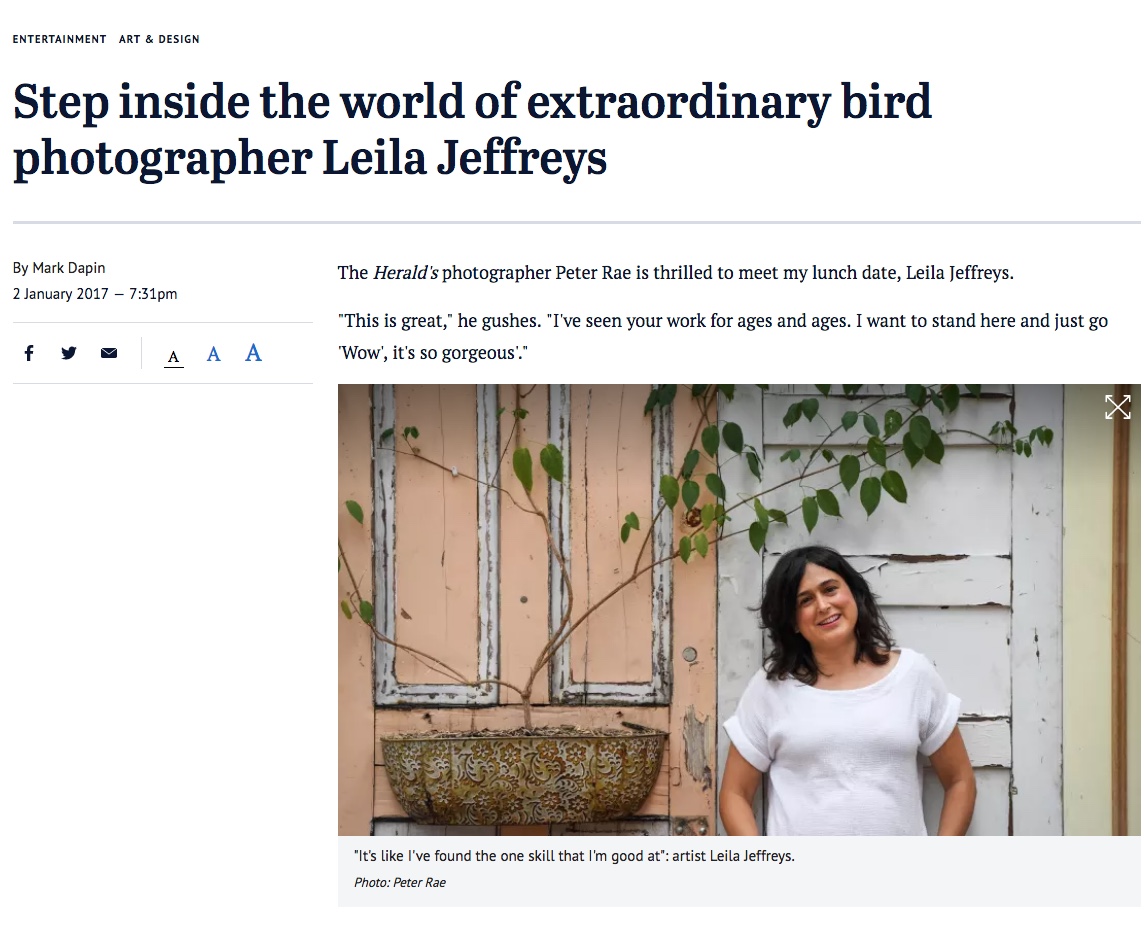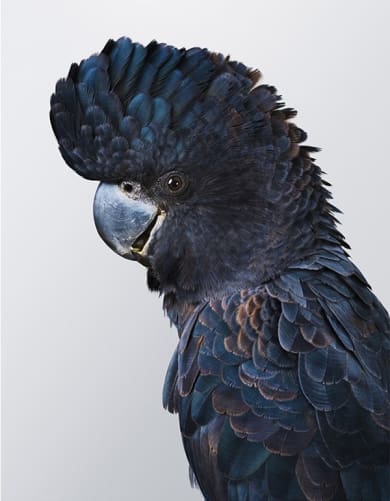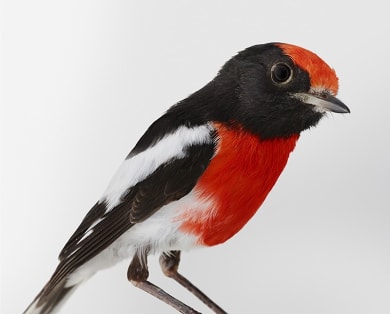Step inside the world of extraordinary bird photographer Leila Jeffreys
The Sydney Morning Herald, Art & Design, 2 January 2017
View article on line at smh.com.au
The Herald's photographer Peter Rae is thrilled to meet my lunch date, Leila Jeffreys.
"This is great," he gushes. "I've seen your work for ages and ages. I want to stand here and just go 'Wow', it's so gorgeous'."
Jeffreys takes the compliment well. "It's like I've found the one skill that I'm good at," she says. And she laughs.
Jeffreys' talent is creating large-scale portrait photographs of birds, and making her subjects appear as complex and characterful as human beings.
She is represented by the Olsen Gallery in Woollahra, where her prints cost up to $4500 each and sell throughout the world. Her work is collected in three books – Bird Love, Bird Land and the limited-edition Interview with a Cockatoo (or Two) – of startlingly neat pictures of imperious penguins, coquettish parakeets and teacherly owls.
We are sitting in the garden of the Henson hotel, Marrickville, around the corner from the home Jeffreys shares with her husband, who has left the legal department of the ABC to work full-time in Jeffrey's bird-photography business.
It's a quiet lunchtime in a pub that caters consciously – and rather brilliantly – for Marrickville's fleeting-but-booming demographic of hipsters-with-young-children. Jeffreys is a regular here, and she orders the gado gado. I ask for the flame-grilled chicken, which appears on the menu as "dirty bird".
The photographer coaxes Jeffreys into a pose.
"I'm warning you," she says. "I'm terrible in front of a camera. I'm much more comfortable behind."
Jeffreys tells me she was born in PNG. Her Anglo-Australian father was a language enthusiast who loved to travel. He met her mother in India and brought her back to Perth, then they moved to Goroka in the Eastern Highlands, where he worked as a teacher and she as a librarian.
They returned to Perth when Jeffreys was five years old. She was educated at Penrhos College, the sister school to Wesley College, where her father was then teaching.
"I was always a bit different at those schools, because of my dad being the way he was," she says. "Our family car was a Kombi. He bought it second hand and he calculated he had driven it the circumference of the globe 25 times – and he still had it many years after he told me that. I used to ask dad to drop me around the corner in the Kombi and I'd walk to school. He made me buy my school formal dress from the op shop, which I was humiliated about – actually, all that stuff I'm quite proud of now, as an adult."
She grew up interested in animals.
"I'd pretend they were my friends," she says. "And my dad used to bring home a lot of injured wildlife." She always felt she had to look after them, thinking, "I'd better get a pillow for it," she says, when "maybe that wasn't what it needed".
Her father took a sabbatical and the family spent what Jeffreys fondly calls her "Jungle Book year" in Naraspur, India, a small village surrounded by wildlife.
Jeffreys says she was a dreamy kid with a wild imagination. She loved taking photographs, and cross-enrolled in a photography course at Curtin University while studying for an Arts degree at Murdoch. On graduation, she moved to London.
Jeffreys loved London for the music. She found a job at Tower Records in Piccadilly Circus, and went to see as many bands as she could. She has eclectic tastes, but is a particular fan of the Byrds.
When she returned to Perth, she worked in an independent record shop then travelled to Sydney to study photography at Ultimo TAFE.
"I tried to be a freelance photographer," she says. "I was actually hopeless. I was quite unconfident and very uncomfortable, which I suppose made people uncomfortable. My photography disappointed me and I knew I wasn't good enough. It really used to annoy me, and I wasn't happy. I kind of fell apart."
Jeffreys only pecks at her colourful gado gado. I make a joke about her birdlike appetite, and instantly regret it.
Once she had failed as a photographer, Jeffreys worked on magazines as a photo editor, and eventually ended up in a management role in syndication at Bauer Media. But she began to crave creative work, and embarked on a personal project to take one great photograph of a budgie.
"That got me into the budgerigar best-in-show world of NSW," she says. "I was dragging my husband to see all these amazing crazy birds. I kept looking at this one particular photo of Jimmy the Budgie and thinking, 'I love this.' That was the first time in my life that I'd taken a photo I was proud of."
They say you only get one Jimmy the Budgie in your lifetime, but Jeffreys thought she might be able to produce a series of photographs, and spent the next two years putting together her budgerigar portfolio. She was pregnant when she began the project. She had her son, Vincent, in 2009, and her first gallery show in 2010. She printed the pictures to make the birds' heads the size of human heads, and they were quickly adopted by stylists to decorate photo shoots in homemaker magazines.
The first gallery that represented her went bust – "That was a very hard lesson for me to learn," she says – but Tim Olsen offered her an exhibition and, in 2012, she put on a show called 'Biloela – Wild Cockatoos'. Once again, it took her two years to complete.
She cut down her days at Bauer media from five to four to three to two, then finally found the nerve to quit and devote herself full-time to her practice as a photographic artist.
I ask Jeffreys what qualities make for a good bird photographer.
"Patience is a big one," she says. "Time. You want to connect, you want to have a bird trust you, you want to look at their body language, you want to follow what they're doing. You can't get a good portrait unless the bird is comfortable, so you talk to them. They don't speak the same language back, but they look at you intensely, they listen to you. If they're not so sure, they move away, and if they're kind of curious they get a bit closer. They might turn their back on you.
"I'm quite awkward about being photographed because I'm conscious of it. They're not self-conscious. Sometimes some of the expressions you get happen because they're inquisitive, and they're looking down the lens thinking, 'What is this?' And they're trying to figure it out."
She says it's very similar to photographing a person, but agrees that people, unlike birds, rarely fly off the perch and land on the photographer's head.
There is a quality to her bird pictures that is difficult to describe. So, for the first time in my career, I'll leave the last word to the photographer: "I don't know what it is," Rae says, "It's intangible. But it captures something that you go … Wow."


